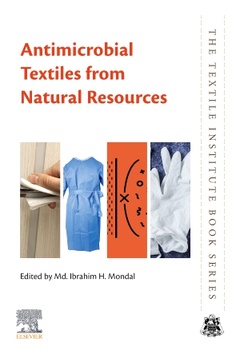Antimicrobial Textiles from Natural Resources The Textile Institute Book Series
Coordonnateur : Mondal Md. Ibrahim H.

The textile industry is focused in its search for alternative green fibres with the aim of providing high-quality products which are fully recyclable and biodegradable. Natural textile materials from renewable sources play an increasingly important role in the industry due to their unique properties and functionality over synthetic fibres, as well as their sustainability.
Antimicrobial Textiles from Natural Resources is an in-depth guide to the latest methods and applications of natural antimicrobial materials. A broad range of applications are addressed, from common to specialized applications, including many in the biomedical sector. This world-class collection of contributors write from a range of disciplinary backgrounds, providing important insights from textile science and technology, materials science, chemical engineering, and biomedical engineering. Advice and proposed solutions are presented in a rigorous and practical way, drawing on results and case studies obtained from academic and industrial laboratories worldwide.
1. Antimicrobial textiles from natural resources: types, properties and processing 2. Microorganisms, infection and the role of medical textiles 3. Common and nano-antimicrobial textile finishes 4. Common, existing and future applications of antimicrobial textile materials 5. Natural antimicrobial agents derived from beneficial microorganisms and plants and their application in the textile industry 6. Processing techniques of antimicrobial textiles 7. Photo-induced antimicrobial agents for textile applications 8. Self-decontaminating antimicrobial textiles 9. Healthcare and hygiene textile products 10. Antimicrobial textiles for skin and wound infection management 11. Antimicrobials for protective clothing 12. Antimicrobial textile materials: their healthcare benefits and management 13. Breathable nonwoven hygienic products 14. Disposable, reusable and biodegradable hygiene products 15. Smart antimicrobial textiles for healthcare professionals and individuals 16. Testing, characterization and regulations of antimicrobial textiles 17. Antimicrobial bacterial cellulose composites as textile materials 18. Nanotechnology in antimicrobial and hygiene materials 19. Electrospun nano?bres with antimicrobial activities 20. Sustainable nanotextiles: emerging antibacterial fabrics
and book chapters, as well as 13 books to his credit as an author, co-author, or editor.
- Examines how natural fibres can be used in the place of less renewable or sustainable choices, thus helping designers improve the sustainability of their products
- Provides unique coverage of the biofunctionality of biopolymers in textiles
- Explains how antimicrobial properties can reduce odour, extend the life of textiles, and provide numerous medical benefits
Date de parution : 03-2021
Ouvrage de 700 p.
15.2x22.8 cm
Thème d’Antimicrobial Textiles from Natural Resources :
Mots-clés :
?Alginate; Alternative antimicrobials; Antibacterial; Antibacterial activity; Antifungal; Antimicrobial; Antimicrobial agent; Antimicrobial agents; Antimicrobial biopolymers; Antimicrobial finish; Antimicrobial nanoparticles; Antimicrobial peptides; Antimicrobial properties; Antimicrobial tests; Antimicrobial textile; Antimicrobial textiles synthesis; Bacterial cellulose; Bactericidal activity; Bioburden; Biocide; Biodegradable polymers; Biofilm; Biopolymers; Breathable; Chitosan; Common antimicrobials; Cosmetics; Cotton fibre; Cytotoxicity; Diapers; Diseases; Durability; Eco-friendliness; Eco-friendly; Electrospinning; Environmental awareness; Fabrics; Fibre modification; Healthcare management; Healthcare textiles; Healthcare-associated infection (HAI); Herbs; Hygiene products; Hygiene sector; Hygiene textiles; Infection; Innovation; Inorganic photocatalysts; Leather; Light irradiation; Medical textile; Membranes; Metal nanoparticles; Microorganisms; Minimization of improper disposal problems; Modes of action; Nanocapsules; Nanochitosan; Nanocomposites; Nanofibres; Nanoparticle; Nanoparticles; Nanotechnology; Nanotextiles; Natural antimicrobials; Natural fibres; Natural plant; Nonwoven; Nosocomial infections; Organic nanoparticles; Organic photosensitisers; Panties; Personal protective equipment; Photoinduced antimicrobial agents; Plant; Poly herbal; Polymers; Potential antimicrobial agents; Potential risks; Protective clothing; Reactive oxygen species; Regulation; Self-decontaminating textiles; Sericin; Skincare; Societal challenges; Sonochemical method; Standards; Surface coating; Textile; Textile finishing; Textile materials; Textile processing; Textiles; Thermoregulation; Wipes; Wound management



